【www.bbyears.com--J2EE/EJB/服务器】
用Windows powershell,加windows的dns服务器。从调整dns服务器解析ip时间段的角度,解决网站负载均衡问题。
win2012r2中,用powershell管理dns服务器的,命令列表
PS C:\Users\admin> get-command * -module DnsServer
CommandType Name ModuleName
----------- ---- ----------
Alias Export-DnsServerTrustAnchor DnsServer
Function Add-DnsServerConditionalForwarderZone DnsServer
Function Add-DnsServerDirectoryPartition DnsServer
Function Add-DnsServerForwarder DnsServer
Function Add-DnsServerPrimaryZone DnsServer
Function Add-DnsServerResourceRecord DnsServer
Function Add-DnsServerResourceRecordA DnsServer
Function Add-DnsServerResourceRecordAAAA DnsServer
Function Add-DnsServerResourceRecordCName DnsServer
Function Add-DnsServerResourceRecordDnsKey DnsServer
Function Add-DnsServerResourceRecordDS DnsServer
Function Add-DnsServerResourceRecordMX DnsServer
Function Add-DnsServerResourceRecordPtr DnsServer
Function Add-DnsServerRootHint DnsServer
Function Add-DnsServerSecondaryZone DnsServer
Function Add-DnsServerSigningKey DnsServer
Function Add-DnsServerStubZone DnsServer
Function Add-DnsServerTrustAnchor DnsServer
Function Add-DnsServerZoneDelegation DnsServer
Function Clear-DnsServerCache DnsServer
Function Clear-DnsServerStatistics DnsServer
Function ConvertTo-DnsServerPrimaryZone DnsServer
Function ConvertTo-DnsServerSecondaryZone DnsServer
Function Disable-DnsServerSigningKeyRollover DnsServer
Function Enable-DnsServerSigningKeyRollover DnsServer
Function Export-DnsServerDnsSecPublicKey DnsServer
Function Export-DnsServerZone DnsServer
Function Get-DnsServer DnsServer
Function Get-DnsServerCache DnsServer
Function Get-DnsServerDiagnostics DnsServer
Function Get-DnsServerDirectoryPartition DnsServer
Function Get-DnsServerDnsSecZoneSetting DnsServer
Function Get-DnsServerDsSetting DnsServer
Function Get-DnsServerEDns DnsServer
Function Get-DnsServerForwarder DnsServer
Function Get-DnsServerGlobalNameZone DnsServer
Function Get-DnsServerGlobalQueryBlockList DnsServer
Function Get-DnsServerRecursion DnsServer
Function Get-DnsServerResourceRecord DnsServer
Function Get-DnsServerRootHint DnsServer
Function Get-DnsServerScavenging DnsServer
Function Get-DnsServerSetting DnsServer
Function Get-DnsServerSigningKey DnsServer
Function Get-DnsServerStatistics DnsServer
Function Get-DnsServerTrustAnchor DnsServer
Function Get-DnsServerTrustPoint DnsServer
Function Get-DnsServerZone DnsServer
Function Get-DnsServerZoneAging DnsServer
Function Get-DnsServerZoneDelegation DnsServer
powershell 传教士 原创文章 2015-11-25改允许转载,但必须保留名字和出处,否则追究法律责任
Function Import-DnsServerResourceRecordDS DnsServer
Function Import-DnsServerRootHint DnsServer
Function Import-DnsServerTrustAnchor DnsServer
Function Invoke-DnsServerSigningKeyRollover DnsServer
Function Invoke-DnsServerZoneSign DnsServer
Function Invoke-DnsServerZoneUnsign DnsServer
Function Register-DnsServerDirectoryPartition DnsServer
Function Remove-DnsServerDirectoryPartition DnsServer
Function Remove-DnsServerForwarder DnsServer
Function Remove-DnsServerResourceRecord DnsServer
Function Remove-DnsServerRootHint DnsServer
Function Remove-DnsServerSigningKey DnsServer
Function Remove-DnsServerTrustAnchor DnsServer
Function Remove-DnsServerZone DnsServer
Function Remove-DnsServerZoneDelegation DnsServer
Function Reset-DnsServerZoneKeyMasterRole DnsServer
Function Restore-DnsServerPrimaryZone DnsServer
Function Restore-DnsServerSecondaryZone DnsServer
Function Resume-DnsServerZone DnsServer
Function Set-DnsServer DnsServer
Function Set-DnsServerCache DnsServer
Function Set-DnsServerConditionalForwarderZone DnsServer
Function Set-DnsServerDiagnostics DnsServer
Function Set-DnsServerDnsSecZoneSetting DnsServer
Function Set-DnsServerDsSetting DnsServer
Function Set-DnsServerEDns DnsServer
Function Set-DnsServerForwarder DnsServer
Function Set-DnsServerGlobalNameZone DnsServer
Function Set-DnsServerGlobalQueryBlockList DnsServer
Function Set-DnsServerPrimaryZone DnsServer
Function Set-DnsServerRecursion DnsServer
Function Set-DnsServerResourceRecord DnsServer
Function Set-DnsServerResourceRecordAging DnsServer
Function Set-DnsServerRootHint DnsServer
Function Set-DnsServerScavenging DnsServer
Function Set-DnsServerSecondaryZone DnsServer
Function Set-DnsServerSetting DnsServer
Function Set-DnsServerSigningKey DnsServer
Function Set-DnsServerStubZone DnsServer
Function Set-DnsServerZoneAging DnsServer
Function Set-DnsServerZoneDelegation DnsServer
Function Show-DnsServerCache DnsServer
Function Show-DnsServerKeyStorageProvider DnsServer
Function Start-DnsServerScavenging DnsServer
Function Start-DnsServerZoneTransfer DnsServer
Function Step-DnsServerSigningKeyRollover DnsServer
Function Suspend-DnsServerZone DnsServer
Function Sync-DnsServerZone DnsServer
Function Test-DnsServer DnsServer
Function Test-DnsServerDnsSecZoneSetting DnsServer
Function Unregister-DnsServerDirectoryPartition DnsServer
Function Update-DnsServerTrustPoint DnsServer
手册在:
https://technet.microsoft.com/library/jj649850(v=wps.630).aspx
------------------------------具体问题-------------------------------------------------
guest问:dns轮询压力不均的问题
最近一直对DNS轮询有一个疑问,我在一个域名下挂了十多个IP,实现简单的负载均衡功能。
但明显发现这种轮询不是很均匀,有一台服务器上的压力始终很高,其他的比较接近,但将此台压力高的从dns列表上去掉后,列表中的下一台压力又会高起来,
此时再把先前那一台加回dns列表,压力就又转回到第一台上去了。已经排除了攻击的可能。这个问题一直困扰了我很久,不知是bind的bug还是我设置ttl或是其他什么的原因,不知有没有高人对这方面有所研究的?
user1答:
DNS 轮询机制会受到多方面的影响,如:A记录的TTL时间长短的影响;别的 DNS 服务器 Cache 的影响;windows 客户端也有一个 DNS Cache。
这些都会影响 DNS 轮询的效果。因此 DNS 的轮询机制并不能做为一个 load balancing 的解决方案,只能作为一个 load distribution 方案。
user2答:
绝大部分网民用的上网系统为WINDOWS系统,在WINDOWS系统上默认开启dns cache服务,这就造成在一个TTL周期内DNS轮询是无效的。
所以为了减小dns cache对轮询效果的影响,通行的做法是减小TTL的值如60-300。(TTL太小也是有害的,故而需要慎重对待)
-------------------------问题分析过程------------------------------------
1 user1,user2说的很好,所以我引用了。ttl不宜太小正常即可。
2 我把这个过程比喻成,【呼啦超】那么多的食客来问你,你家的饭店的分店咋走,然后进你家的分店,去吃喝。
你家饭店假设有n家分店,每家最大接待能力不同,当前拥有的客人数不同,剩余的接待能力不同。
3 由于上两个人说的问题,导致了这样的结果,你不可能知道未来啥时候有食客来查分店地址(时间),因为有缓存,你也不可能知道未来食客具体有多少人(用户数量)。你也不可能知道查了ip的食客中,有多少会来吃。
4 所以说必须有一个【每分店剩余接待能力反馈】!
即有一个值,服务器连接失败,取值失败,则返回-1。-1太多则报警。
值为0,则代表分店客满,0太多则报警。我ps脚本就会跳过这家分店。
正常的值为0----1之间的数,表示这家分店的接の客能力。每个服务器有了这个数值供给,剩下就好办了。
5 为什么用win的dns?
答:
5.1 主要因为有powershell。
我记得bind无法用命令添加a记录等,并立即生效。这样的话拍马也赶不上powershell了!你要搞个程序去修改dns区域文件,然后reload分区。这样性能很差吧。
powershell命令管理dns是内存操作。主要用到的命令就这四个:
Add-DnsServerResourceRecordA,Add-DnsServerResourceRecordCName,Get-DnsServerResourceRecord,Remove-DnsServerResourceRecord
5.2 win的dns性能无问题:我记得bind是多进程的程序,可以用多核跑,无性能制约。而win2000中说win的dns比bind效率高。
dns还都是10年前都成熟的东西。退一万步来讲,win的dns玩一千个以下的ip解析,不会有性能问题。
5.3 可以用win做主dns服务器,linux+bind做缓存。win放内网,linux放外网,只从外网dns缓存取数据。
-------------------------我给出的,问题解题流程------------------------------------
1 用任务计划,每1---n分钟定期调用powershell脚本解题。这里假设都是1分钟。
脚本运行后,把自己的pid放入环境变量,然后继续运行。
脚本重新运行后,从环境变量中查找前一个脚本的pid,杀死前一个脚本。然后重复上一步,避免脚本死锁。
2 用一个ps程序,从每家分店取回来,每家分店的(剩余)接待能力。
即有一个值,服务器连接失败,取值失败,则返回-1。-1太多则报警。
值为0,则代表分店客满,0太多则报警。我ps脚本就会跳过这家分店。
正常的值为0----1之间的数,表示这家分店的接の客能力。
powershell 传教士 原创文章 2015-11-25改允许转载,但必须保留名字和出处,否则追究法律责任
3 从这n家分店返回的接客能力中,总是挑2家最闲(数值最大)分店,把这2个新的a记录写入dns,然后删除所有旧的a记录。
设【取接待能力时间】为α秒,这里暗含着等待60-α-2秒。α如果较大则应增加任务计划分钟数。
结论:
我这个方法就是用dns来搞均衡,
我这个方法就是要告诉你,怎么搞的很均衡。
就是用我发明的填坑法,永远只填最大的两个坑!永远把最空闲的服务器的ip,放入dns服务器,解析给客户!
-------------------------解题具体脚本------------------------------------
#Requires -RunAsAdministrator
# 更换dns的a记录,到最大接待能力2台机的ip子上。
[string]$域名 = "aaaaxxxx.com"
[string]$主机名 = "ppp"
[int32]$服务器客满值 = 3
[int32]$服务器无响应值 = 2
$日志文件存储位置 = 'd:\aaa.txt'
$分店01 = @{'ip' = '1.2.3.4';'接待能力' = 0}
$分店02 = @{'ip' = '2.2.3.4';'接待能力' = 0}
$分店03 = @{'ip' = '3.2.3.4';'接待能力' = 0}
$分店04 = @{'ip' = '4.2.3.4';'接待能力' = 0}
$分店05 = @{'ip' = '5.2.3.4';'接待能力' = 0}
$分店06 = @{'ip' = '6.2.3.4';'接待能力' = 0}
$分店07 = @{'ip' = '7.2.3.4';'接待能力' = 0}
$分店08 = @{'ip' = '8.2.3.4';'接待能力' = 0}
$分店09 = @{'ip' = '9.2.3.4';'接待能力' = 0}
$分店10 = @{'ip' = '10.2.3.4';'接待能力' = 0}
$各分店集合 = $分店01,$分店02,$分店03,$分店04,$分店05,$分店06,$分店07,$分店08,$分店09,$分店10
if ($env:dnschanger_pid -ne $null)
{
$temp001 = Get-Process -id $env:dnschanger_pid
if ($temp001 -ne $null)
{
Stop-Process $temp001 -Force
}
}
[System.Environment]::SetEnvironmentvariable("dnschanger_pid","$PID", "user")
function 获取分店接待能力
{
<#
这个函数返回一个值。
若服务器连接失败,或取值失败,则返回-1。-1太多则报警。
值为0,则代表分店客满,0太多则报警。我ps脚本就会跳过这家分店。
正常的返回值为0----1之间的数,表示这家分店的接の客能力。
#>
}
function 服务器客满报警
{
}
function 服务器无响应报警
{
}
# 无响应返回 -1,客满返回0,正常返回0----1间的值
$分店01.'接待能力' = 获取分店接待能力 "aaa" 123
$分店02.'接待能力' = 获取分店接待能力 "aaa" 123
$分店03.'接待能力' = 获取分店接待能力 "aaa" 123
$分店04.'接待能力' = 获取分店接待能力 "aaa" 123
$分店05.'接待能力' = 获取分店接待能力 "aaa" 123
$分店06.'接待能力' = 获取分店接待能力 "aaa" 123
$分店07.'接待能力' = 获取分店接待能力 "aaa" 123
$分店08.'接待能力' = 获取分店接待能力 "aaa" 123
$分店09.'接待能力' = 获取分店接待能力 "aaa" 123
$分店10.'接待能力' = 获取分店接待能力 "aaa" 123
$各分店接待能力集合 = $分店01.'接待能力',$分店02.'接待能力',$分店03.'接待能力',$分店04.'接待能力',$分店05.'接待能力',$分店06.'接待能力',$分店07.'接待能力',$分店08.'接待能力',$分店09.'接待能力',$分店10.'接待能力'
[system.array]::Sort($各分店接待能力集合)
$分组 = Group-Object -InputObject $各分店接待能力集合
if (($分组[0].name -eq -1) -and ($分组[0].Count -gt $服务器无响应值) )
{
服务器无响应报警
$err_msg = '服务器无响应!'
Write-Error $err_msg
$日期 = Get-date -Format F
Add-Content -Value $("$日期 $err_msg") -LiteralPath $日志文件存储位置
exit 1
}
if (($分组[0].name -eq 0) -and ($分组[0].Count -gt $服务器客满值) )
{
服务器客满报警
$err_msg = '客满分店太多!'
Write-Error $err_msg
$日期 = Get-date -Format F
Add-Content -Value $("$日期 $err_msg") -LiteralPath $日志文件存储位置
exit 2
}
# -----------------------------------------
$状元 = $各分店接待能力集合[-1]
$榜眼 = $各分店接待能力集合[-2]
foreach ($temp011 in $各分店集合)
{
if ($temp011.'接待能力' -eq $状元)
{
[string]$ip1 = $temp011.'ip'
}
if ($temp011.'接待能力' -eq $榜眼)
{
[string]$ip2 = $temp011.'ip'
}
}
#Import-Module -name DnsServer
$旧的dns记录 = Get-DnsServerResourceRecord -ZoneName $域名 -Name $主机名 -RRType "A"
$旧的ip = $旧的dns记录.RecordData.IPv4Address.IPAddressToString
Add-DnsServerResourceRecord -A -ZoneName $域名 -Name $主机名 -IPv4Address $ip1 -TimeToLive 01:00:00
Add-DnsServerResourceRecord -A -ZoneName $域名 -Name $主机名 -IPv4Address $ip2 -TimeToLive 01:00:00
#Add-DnsServerResourceRecord -CName -ZoneName $域名 -Name $主机名 -HostNameAlias "Host34.lab.com" -TimeToLive 01:00:00
foreach ($temp002 in $旧的ip)
{
Remove-DnsServerResourceRecord -ZoneName $域名 -Name $主机名 -RRType "A" -RecordData $temp002 -Force
}
利用dns解析来实现网站的负载均衡
当网站的访问量大了就会考虑负载均衡,这也是每一个架构师的基本功了,其基本地位就相当于相声里的说学逗唱,活好不好就看这个了 :)
传统的负载均衡思路是单点的,不管你是硬件的还是软件的基本都是这样的原理
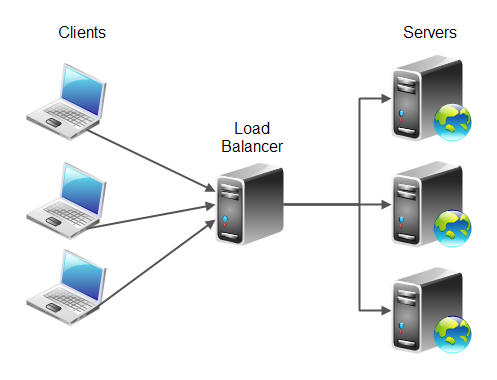
对于一般的需求来说,这样的架构基本就可以解决问题了。而且维护起来也相对简单。嗯,大多数公司也都是这么干的。
传统思路的局限性
就如同上图所示,传统思路也存在非常明显的局限性。也就是网站的响应速度很大程度上局限于负载均衡节点的能力,而且一旦负载均衡节点本身挂掉的话,整个网站就完全瘫痪了。后端的服务可以水平扩展,但是对于单个节点来说就算你再增大机器的配置也是有极限的,而且这也不符合互联网技术的发展规律。
CDN是怎么做的
作为互联网上承载大部分流量的一大基础设施,CDN对负载分流的解决思路很具有启发性
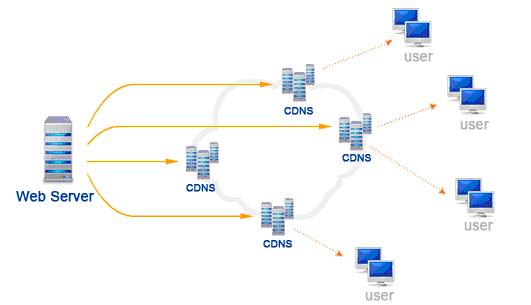
从上图可以看到,用户的访问被分流了,所有的请求不再是聚集到一个节点上,而是被分担在了各个合适的节点上,这样即使存在单点故障,也仅仅只会影响到一部分用户,况且我们还可以使用其他手段做故障转移。
同样的做法也可以借鉴到传统的BS架构中,我们也可以把用户的请求直接分流到不同的服务器上,而不必经过一个统一的节点中转。这个分流是通过什么做到的呢?答案就是 DNS!
你知道DNS是怎么工作的吗?
大部分人可能天天都用着DNS却不知道它的基本原理,你可能知道我们访问互联网需要查询dns服务器,就是下面的这个玩意
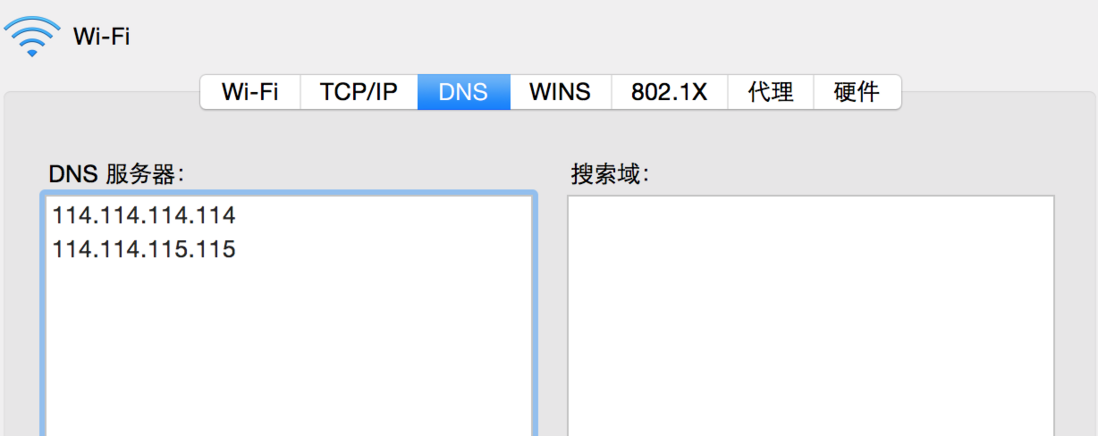
我们只需要问它域名所对应的ip地址就行了。但事情真的这么简单吗?它是怎么知道这个域名所对应的ip地址呢?
其实dns系统是一个典型的树状架构,上图所示的dns服务器其实应该叫dns缓存查询服务器,它是为了减轻互联网上dns查询的负载所设计的。如果你的请求没有命中缓存,那么这个缓存服务器就会自己进行一次标准查询,然后再把结果缓存起来,简单来说就是从根服务器开始一级一级的问。我们以前经常谈到根服务器的重要性其实就体现在这里了,它保留了对所有域名的起始解释权
神奇的解释权机制(SOA)
上面讲到根服务器拥有一切域名的起始解释权,但是如果你去问根服务器它是不会直接告诉你最终答案的。因为如果它要存储所有的记录,那它也太累了,这个负载和开销是惊人的。那它会告诉你什么呢?它会告诉你应该去问谁,也就是它授权下一级服务器来解答你的问题。拟人化这个过程
我: root, root 告诉我, segmentfault.com 怎么走?
root: 呵呵,你可以去问.com的dns服务器,地址是xxxxxx
我: .com, .com 告诉我,segmentfault.com 怎么走?
.com: 呵呵,你可以去问segmentfault.com的dns服务器(dnspod之类的),地址是xxxxxx
我: dnspod, dnspod 告诉我,segmentfault.com 怎么走?
dnspod: 拿着 xxxxxx,走你
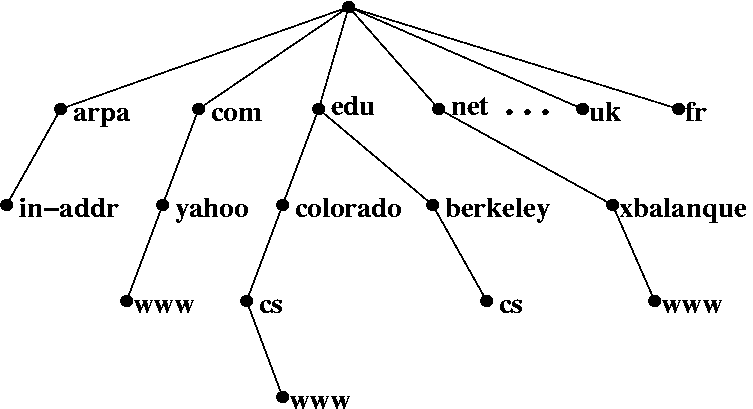
DNS负载均衡的基本原理
了解了上述过程,我们得到两个基本结论
dns系统本身是一个分布式的网络,它是相对可靠的,起码比你网站本身可靠的多
dns的最终解释是可以受我们自己控制的
有了这两条结论,剩下的事情就简单了,我们只需要在最终解释的查询结果上做文章就可以了。简单来说,就是将你的所有服务器地址,按照自己需求制定的频次,返回给用户。
以github.com为例,我们首先获取它的SOA服务器(因为dns缓存查询服务器会缓存结果,如果你直接去查询域名,会每次返回一样的结果),.com的dns域名服务器也是13台,它们是[a-m].gtld-servers.net,我们随便选一台来找找github.com的SOA
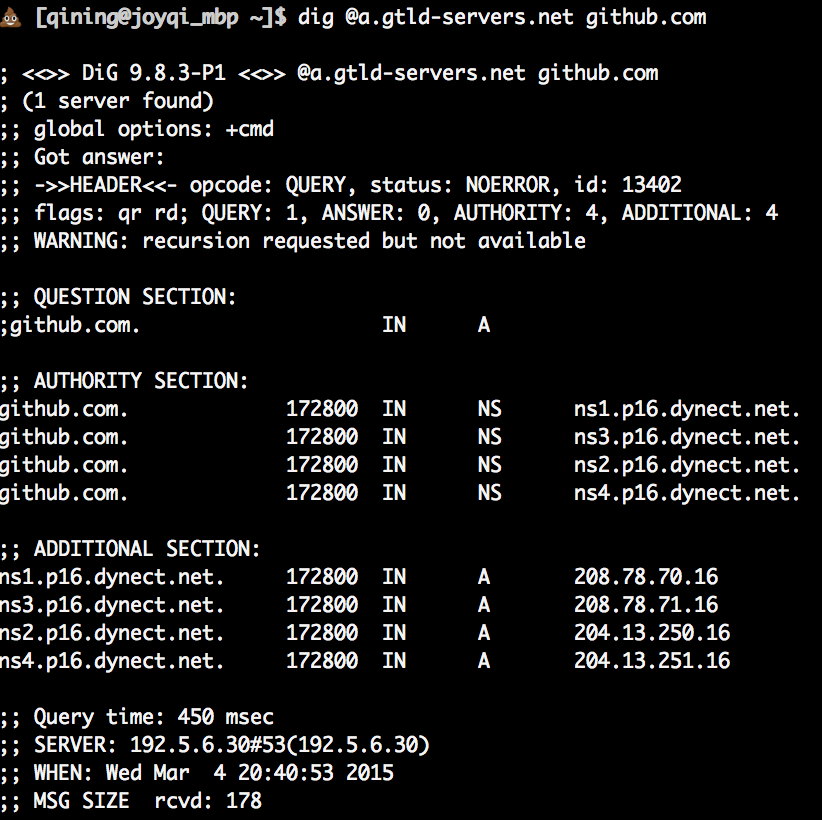
OK,我们获取了四个SOA服务器ns[1-4].p16.dynect.net,再随便选一个来问问github.com对应的记录吧,顺便试几次看看最终的ip地址会不会变化
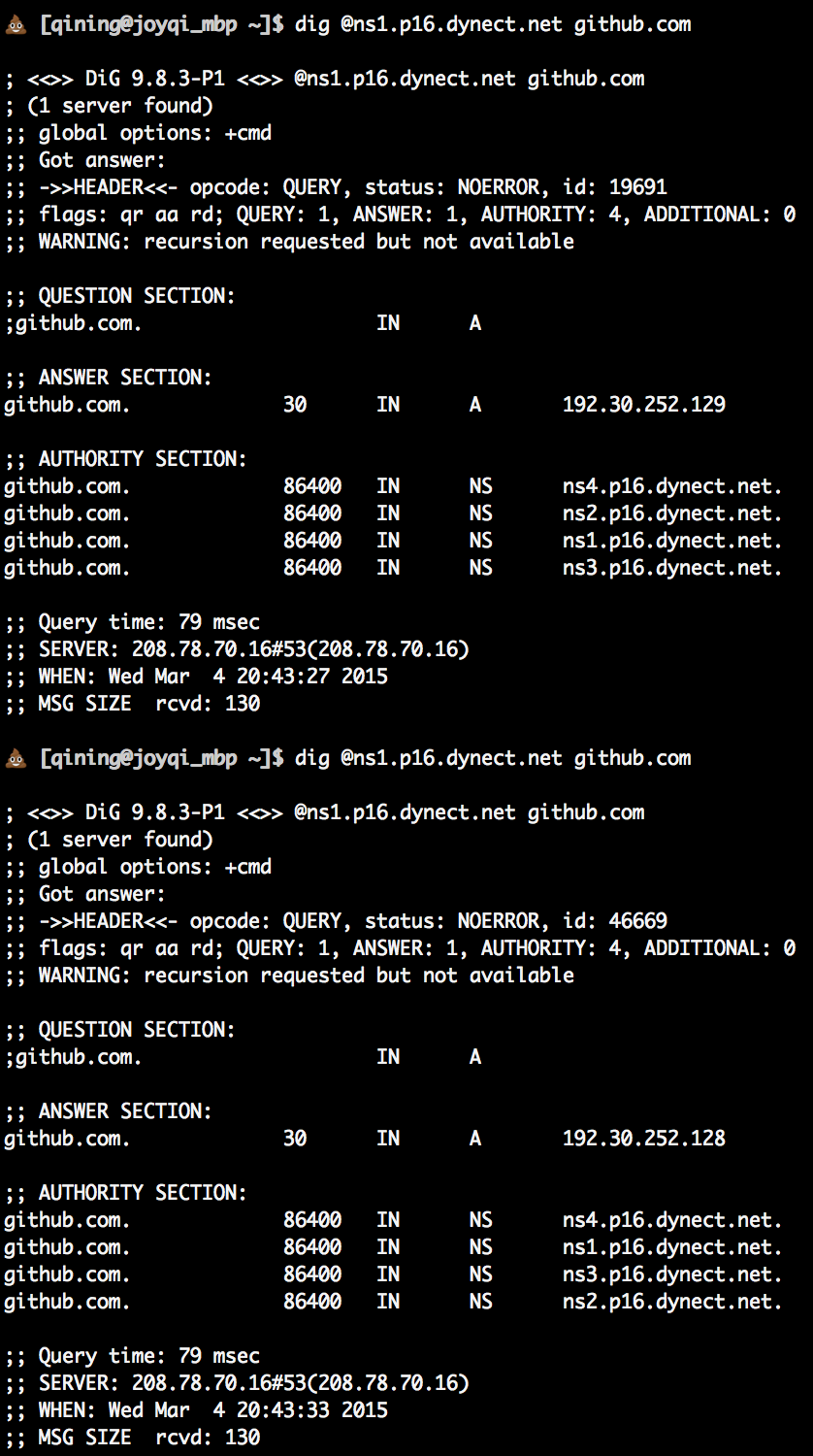
我们这里查询了两次,注意ANSWER SECTION部分返回了两个结果,一次是192.30.252.129,一次是192.30.252.128。
这就是利用dns实现了负载均衡,你的最终访问会到达不同的ip地址。
有哪些DNS服务商支持负载均衡呢?
这是一种比较高级的服务,一般域名注册商的dns服务器不会支持,目前我已知支持它的服务商有
AWS Route 53
NSONE
Dyn
dnspod
其中1和4是我们已经在使用的,效果比较理想。
总结
其实DNS可以玩的花样远不止这些,还可以做故障转移,也可以按地区解析等等。域名从互联网诞生之初就开始存在了,但是对它的研究以及衍生出来的使用方法才刚刚开始发掘,随着大家对互联网利用的提升,这类技术肯定会越来越多。